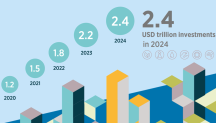

4 Reasons Renewables Can Help Defeat Climate Change
Newsletter
Global leaders, government representatives and devout environmental activists all converge in Lima, Peru this week for the 2014 session of the United Nations Climate Change Conference. A midst the jet lag, registration queues and flashing cameras, one question holds sway: what can be done to reverse the effects of climate change and preserve the planet for our children and our children's children?
This question is at the base of all questions negotiators will be tackling in Lima.
So what can be done? IRENA argues that renewable energy, in combination with energy-efficiency measures, offers the best chance to avoid the worst effects of climate change.
Here's why:
ONE: Energy is where the emissions are. Energy accounts for two-thirds of global greenhouse gas emissions and energy demands are growing. In 2030, the planet will be home to 8 billion people and these people will demand 60% more electricity that we use today. For this reason, renewable energy combined with energy efficiency have a large role to play in mitigating climate change. IRENA research says a doubling of the world's share of renewable energy by 2030, from around 18% today to 36%, would help avoid the worst effects of climate change.
TWO: The switch to renewables is completely possible, now. We already have the needed technology to double renewables by 2030, and investment is rising to help meet this goal. Global investment in renewable generating capacity (excluding large hydro) has risen significantly over the last decade from 55 billion dollars in 2004 to 214 billion dollars in 2013 and investment in new renewable capacity has exceeded investment in new fossil-based power generation capacity for three years running.
THREE: Renewables are cheap. We all know that money talks, and the more expensive option is rarely chosen in business. The good news is, REmap 2030 shows that doubling the global share of renewables is actually cheaper than not doing so. Renewable energy is now the most cost-competitive source of power in many parts of the world. Additionally, when considering factors like the cost of pollution (including ill health, environmental degradation and carbon emissions), switching to renewable energy could save up to USD 740 billion per year by 2030.
FOUR: Renewables are good for the economy. Renewable energy has a ripple effect throughout society, simultaneously improving public health and security, creating jobs, boosting Gross Domestic Product and improving the balance of trade. IRENA research finds that renewable energy jobs reached 6.5 million globally in 2013 (the coal sector employed 7 million people in the same year). If steps are taken to double the share of renewable energy, we estimate there will be 16.7 million cumulative additional direct renewable energy jobs by 2030.
Renewables can help defeat climate change, but more action is needed. If policies stay as is, IRENA forecasts that instead of doubling the share of renewables to 36% by 2030, we will reach only 21%. This is far from sufficient to mitigate the trend of global warming.
Making the renewables transition will require urgent, bold steps, from leaders willing to take the short-term hits from those who would rather carry on with business as usual. Vested interests and short term thinking are important barriers that need to be overcome. It will be a battle. But it is a battle we simply cannot afford to lose.
More on renewables and climate change



